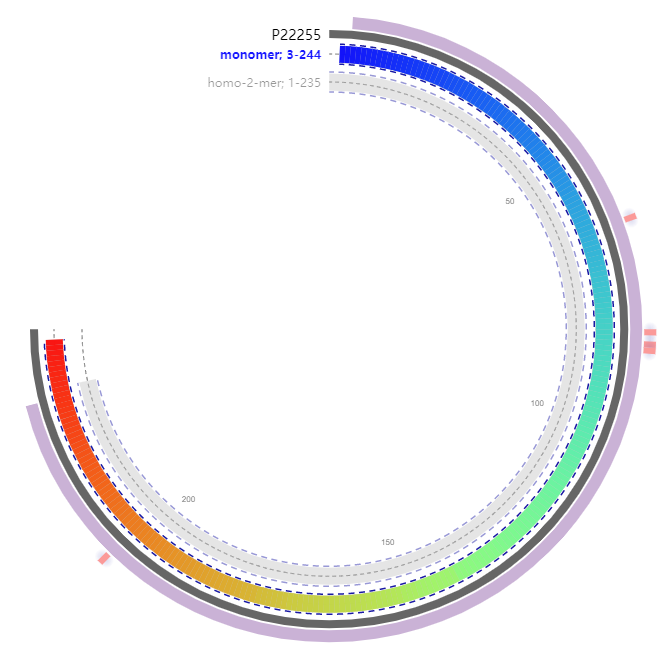Converts adenosine-3',5'-bisphosphate (PAP) to AMP. May also convert adenosine 3'-phosphate 5'-phosphosulfate (PAPS) to adenosine 5'-phosphosulfate (APS). adenosine 3',5'-bisphosphate + H2O = AMP + phosphate
MLDQVCQLARNAGDAIMQVYDGTKPMDVVSKADNSPVTAADIAAHTVIMDGLRTLTPDVP
VLSEEDPPGWEVRQHWQRYWLVDPLDGTKEFIKRNGEFTVNIALIDHGKPILGVVYAPVM
NVMYSAAEGKAWKEECGVRKQIQVRDARPPLVVISRSHADAELKEYLQQLGEHQTTSIGS
SLKFCLVAEGQAQLYPRFGPTNIWDTAAGHAVAAAAGAHVHDWQGKPLDYTPRESFLNPG
FRVSIY
251

| PMID | Title & Author | Abstract | Year | |
| 0 | 10224133 | Cloning and characterization of a mammalian lithium-sensitive bisphosphate 3'-nucleotidase inhibited by inositol 1,4-bisphosphate.Spiegelberg BD, Xiong JP, Smith JJ, Gu RF, York JD | Discovery of a structurally conserved metal-dependent lithium-inhibited phosphomonoesterase protein family has identified several potential cellular targets of lithium as used to treat manic depression. Here we describe identification of a novel family member using a "computer cloning" strategy. Human and murine cDNA clones encoded proteins sharing 92% identity and were highly expressed in kidney. Native and recombinant protein harbored intrinsic magnesium-dependent bisphosphate nucleotidase activity (BPntase), which removed the 3'-phosphate from 3'-5' bisphosphate nucleosides and 3'-phosphoadenosine 5'-phosphosulfate with Km and Vmax values of 0.5 microM and 40 micromol/min/mg. Lithium uncompetitively inhibited activity with a Ki of 157 microM. Interestingly, BPntase was competitively inhibited by inositol 1,4-bisphosphate with a Ki of 15 microM. Expression of mammalian BPntase complemented defects in hal2/met22 mutant yeast. These data suggest that BPntase's physiologic role in nucleotide metabolism may be regulated by inositol signaling pathways. The presence of high levels of BPntase in the kidney are provocative in light of the roles of bisphosphorylated nucleotides in regulating salt tolerance, sulfur assimilation, detoxification, and lithium toxicity. We propose that inhibition of human BPntase may account for lithium-induced nephrotoxicity, which may be overcome by supplementation of current therapeutic regimes with inhibitors of nucleotide biosynthesis, such as methionine. | 1999 |
| 1 | 18443146 | Degradation of several hypomodified mature tRNA species in Saccharomyces cerevisiae is mediated by Met22 and the 5'-3' exonucleases Rat1 and Xrn1.Chernyakov I, Whipple JM, Kotelawala L, Grayhack EJ, Phizicky EM | Mature tRNA is normally extensively modified and extremely stable. Recent evidence suggests that hypomodified mature tRNA in yeast can undergo a quality control check by a rapid tRNA decay (RTD) pathway, since mature tRNA(Val(AAC)) lacking 7-methylguanosine and 5-methylcytidine is rapidly degraded and deacylated at 37 degrees C in a trm8-Delta trm4-Delta strain, resulting in temperature-sensitive growth. We show here that components of this RTD pathway include the 5'-3' exonucleases Rat1 and Xrn1, and Met22, which likely acts indirectly through Rat1 and Xrn1. Since deletion of MET22 or mutation of RAT1 and XRN1 prevent both degradation and deacylation of mature tRNA(Val(AAC)) in a trm8-Delta trm4-Delta strain and result in healthy growth at 37 degrees C, hypomodified tRNA(Val(AAC)) is at least partially functional and structurally intact under these conditions. The integrity of multiple mature tRNA species is subject to surveillance by the RTD pathway, since mutations in this pathway also prevent degradation of at least three other mature tRNAs lacking other combinations of modifications. The RTD pathway is the first to be implicated in the turnover of mature RNA species from the class of stable RNAs. These results and the results of others demonstrate that tRNA, like mRNA, is subject to multiple quality control steps. | 2008 |
| 2 | 8721754 | The SAL1 gene of Arabidopsis, encoding an enzyme with 3'(2'),5'-bisphosphate nucleotidase and inositol polyphosphate 1-phosphatase activities, increases salt tolerance in yeast.F J Quintero, B Garciadeblás, A Rodríguez-Navarro | A cDNA library in a yeast expression vector was prepared from roots of Arabidopsis exposed to salt and was used to select Li(+)-tolerant yeast transformants. The cDNA SAL1 isolated from one of these transformants encodes a polypeptide of 353 amino acid residues. This protein is homologous to the HAL2 and CysQ phosphatases of yeast and Escherichia coli, respectively. Partial cDNA sequences in the data bases indicate that rice produces a phosphatase highly homologous to SAL1 and that a second gene homologous to SAL1 exists in Arabidopsis. The SAL1 protein expressed in E. coli showed 3'(2'),5'-bisphosphate nucleotidase and inositol polyphosphate 1-phosphatase activities. In yeast, SAL1 restored the ability of a hal2/met22 mutant to grow on sulfate as a sole sulfur source, increased the intracellular Li+ tolerance, and modified Na+ and Li+ effluxes. We propose that the product of SAL1 participates in the sulfur assimilation pathway as well as in the phosphoinositide signaling pathway and that changes in the latter may affect Na+ and Li+ fluxes. | 1996 |
Verma, D. P S . A Rice HAL2-like Gene Encodes a Ca[IMAGE]-sensitive 3`(2`),5`-Diphosphonucleoside 3`(2`)-Phosphohydrolase and Complements Yeast met22 and Escherichia coli cysQ Mutations[J]. Journal of Biological Chemistry, 1995, 270(49):29105-29110.